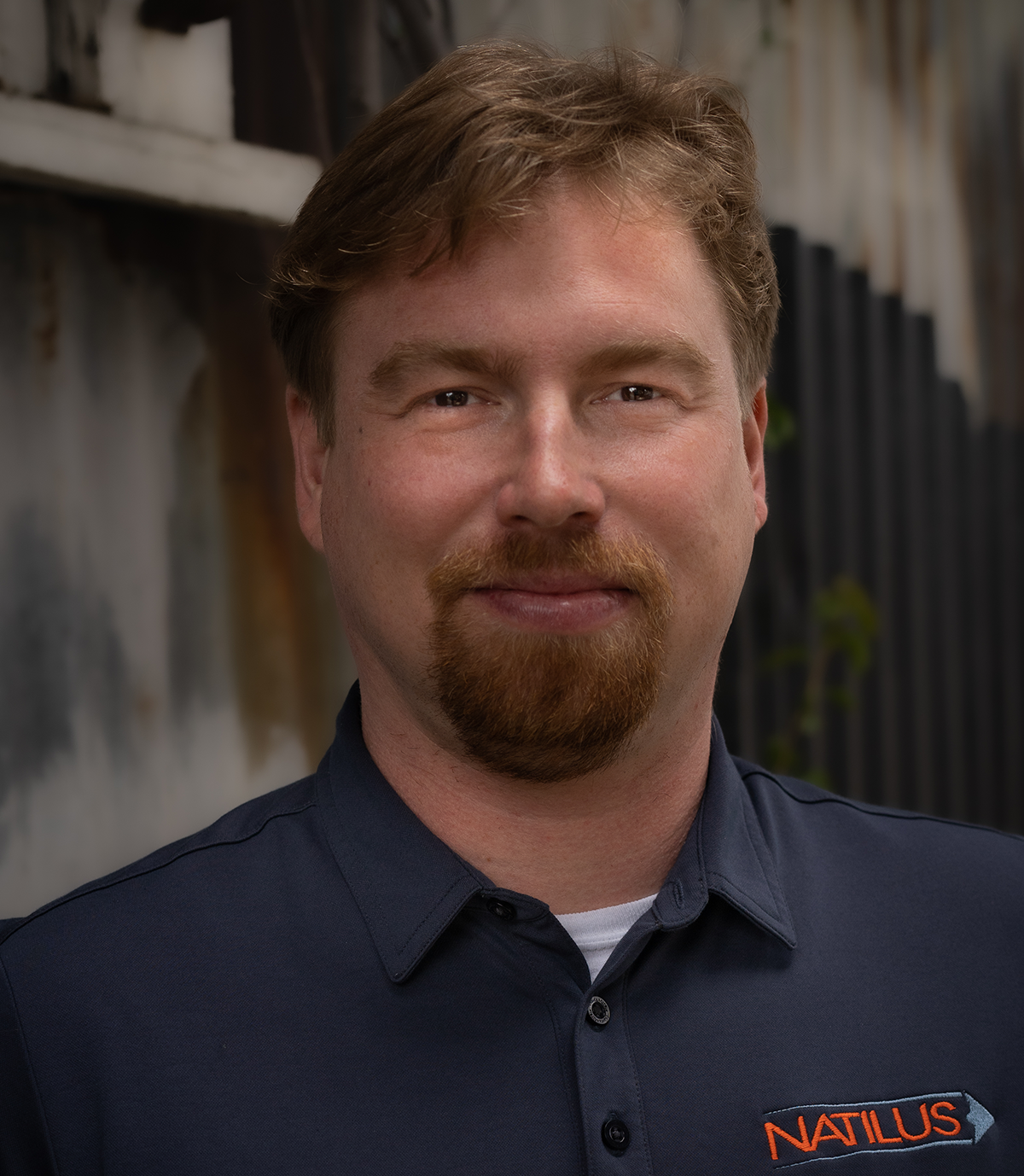The mission of Natilus is to commoditize freight transport by making air cargo transportation more efficient. Natilus can lower air cargo costs by 60% and increase cargo volume by 60%, while cutting carbon emissions in half.
Natilus was co-founded by Aleksey Matyushev, and Anatoly Star in 2016.
Aleksey Matyushev serves as CEO of Natilus. Early in his career, he was the Lead Aerodynamicist at Piper Aircraft, helping to lead the department through programs including the PiperJet Altaire, the M600 and other future designs. Later, at Kratos Defense he served as the aerodynamics lead on military UAV systems. After Kratos, through his consulting practice, Aleksey supported a multitude of General Aviation and UAS programs in aircraft design, performance, stability & control, flight testing, loads, CFD, and certification. Aleksey holds an Aerospace Engineering degree from Embry Riddle Aeronautical University.
Anatoly serves as Head of Operations at Natilus, with more than a decade of industry experience in rapid prototype development for a multitude of aircraft programs. He has done structural and mechanical systems design and testing programs, including PiperJet Altaire, Boeing 747-8, and Bombardier Global 7500. He is an experienced fabricator of all parts of the airframe, whether aluminum or composite, and is skilled at powerplant build-up. Anatoly is an avid aircraft home builder and pilot and holds a patent in mechanical system design. Anatoly holds an Aerospace Engineering degree from Embry-Riddle Aeronautical University.
Today, there are only two ways to move cargo internationally, by air and sea. The difference between the cost and time of these two modes of transportation is dramatic. While sea freight is 13 times less expensive than air freight, it is 50 times slower in delivery – limiting goods which require rapid delivery, such as food, pharmaceuticals, vaccines, and other perishables
Natilus revolutionizes the transport industry by providing the timeliness of air freight at an affordable cost reduction of 60%, making air cargo transportation substantially more competitive. Our BWB aircraft takes this one step further by offering a 50% reduction in emissions today, SAF compatibility, and exploring next-generation propulsion technology. With these advancements, we are not only providing a more cost-effective and timely mode of transportation but also a more sustainable one.
At Natilus, we believe that the future of cargo transportation is autonomous aircraft, and we are leading the way in this innovative space. Our mission is to create a more sustainable and efficient future for all. We are excited to continue pushing the boundaries of what is possible in the cargo industry, leveraging the latest technology and innovation to make air cargo transportation more efficient, cost-effective, and environmentally friendly.
Natilus is offering fully autonomous cargo aircraft for greater efficiency and cost-savings and provides remote piloting for additional security, allowing for substantial scaling of operations for air freight.
Natilus currently has more than $6.8 billion in order commitments, and 460+ aircraft in pre-orders, from companies including major airlines and integrators: Ameriflight, Volatus Aerospace, Flexport, Astral, Aurora International, and Dymond.
First flight of the full-scale prototype will be in 2024. Natilus has completed two wind tunnel tests to validate the aircraft.
With a patent-pending ‘Diamond’ cargo-bay, Natilus offers an efficient blended wing body configuration that allows for 60% more volume. Designed around cargo, the aircraft can hold a large configuration of standard pallets, outsized cargo, and without a contouring requirement. All with a remote pilot watching over.
Natilus is reinventing the 75-year-old status quo of freight transportation through innovation and advanced technologies, to make air freight costs competitive to cargo shipping and dramatically improve delivery times.
Natilus has designed and developed a blended-wing, autonomous global air freight system that can offer services at a fraction of the cost of today’s transport, while reducing negative impacts on our environment.
Autonomous operations are the safest form of air transportation as statistics show that 95% of accidents are currently pilot errors. Whether the flight operations warrant a FAA-certified UAV or the aerospace regulations call for human pilot controls, Natilus also offers remote Fly-by-Mouse autopilot, adding additional levels of security and safety.
When most individuals think about drones, they usually refer to what has started out as consumer products, usually weighing less than 50 lbs / 23 kg with limited payloads and ranges. Autonomous aircraft are a class of ‘manned’ aircraft (typically weighing higher than 500 lbs / 227 kg) that have been injected with autonomy.
$5 Trillion global supply chain is in crisis. Natilus aircraft use the existing ground infrastructure and standard air cargo containers, making Natilus products a turnkey solution for its customers.
Natilus is supported by top-tier Silicon Valley investors such as Draper Associates, Mubadala, VU Ventures, Liquid2 VC, Seraph Group among many others. The company, headquartered in San Diego, CA, said the new round of funding will help the team build the full-scale version of the Kona freighter and fund the program through first flight.
Converted freighters are a great way for airlines to capture the low-priced feedstock and re-purpose it for air freight. The conversions do introduce added weight and lower performance than a purpose-built freighter. Natilus outperforms all converted aircraft in operating cost and performance.
The triangular shape of the Blended Wing Body (BWB) configuration is a fundamental departure from tube and wing aircraft which feature linear (forward/backward) cargo loading architecture. By rotating the cargo to 45 degrees, the ‘diamond’ configuration introduces more loading positions at smaller aircraft size – maximizing the real estate of the BWB. Natilus aircraft are smaller in size than their tube and wing counterparts with more volume.
Traditional tube and wing aircraft fuselage cross-sections are optimized for passengers – specifically cabin pressurization through the circular cross-section. Cargo naturally gravitates towards rectangular pallets. Fitting rectangular pallets in a circular fuselage section leaves a lot of space under-utilized. With a BWB configuration, there is a single rectangular cross-section allowing full utilization of all available volume in the aircraft.
Yes, Natilus is growing rapidly and is always looking for talented individuals. We believe that the future is built with a small, talented team. Check the Natilus careers page for details and how to apply.
Natilus was co-founded by Aleksey Matyushev, and Anatoly Star in 2016.
Aleksey Matyushev serves as CEO of Natilus. Early in his career, he was the Lead Aerodynamicist at Piper Aircraft, helping to lead the department through programs including the PiperJet Altaire, the M600 and other future designs. Later, at Kratos Defense he served as the aerodynamics lead on military UAV systems. After Kratos, through his consulting practice, Aleksey supported a multitude of General Aviation and UAS programs in aircraft design, performance, stability & control, flight testing, loads, CFD and certification. Aleksey holds an Aerospace Engineering degree from Embry Riddle Aeronautical University.
Anatoly serves as Chief Engineer of Natilus, with more than a decade of industry experience in rapid prototype development for a multitude of aircraft programs. He has done structural and mechanical systems design and testing programs, including PiperJet Altaire, Boeing 747-8, and Bombardier Global 7500. He is an experienced fabricator of all parts of the airframe, whether aluminum or composite, and is skilled at powerplant build up. Anatoly is an avid aircraft home builder and pilot and holds a patent in mechanical system design. Anatoly holds an Aerospace Engineering degree from Embry-Riddle Aeronautical University.
Natilus is offering fully autonomous cargo aircraft for greater efficiency and cost-savings and provides remote piloting for additional security, allowing for substantial scaling of operations for air freight.
Natilus currently has more than $6 billion in order commitments, and 440+ aircraft in pre-orders, from companies including major airlines and integrators: Volatus Aerospace, Flexport, Astral, Aurora International, and Dymond.
Natilus is reinventing the 75-year-old status quo of freight transportation through innovation and advanced technologies, to make air freight costs competitive to cargo shipping and dramatically improve delivery times.
Natilus has designed and developed a blended-wing, autonomous global air freight system that can offer services at a fraction of the cost of today’s transport, while reducing negative impacts on our environment.
When most individuals think about drones, they usually refer to what has started out as consumer products, usually weighing less than 50 lbs / 23 kg with limited payloads and ranges. Autonomous aircraft are a class of ‘manned’ aircraft (typically weighing higher than 500 lbs / 227 kg) that have been injected with autonomy.
Natilus is supported by top-tier Silicon Valley investors such as Draper Associates, Mubadala, VU Ventures, Liquid2 VC, Seraph Group among many others. The company, headquartered in San Diego, CA, said the new round of funding will help the team build the full-scale version of the N38T freighter and fund the program through first flight.
Traditional tube and wing aircraft fuselage cross-sections are optimized for passengers – specifically cabin pressurization through the circular cross section. Cargo naturally gravitates towards rectangular pallets. Fitting rectangular pallets in a circular fuselage section leaves a lot of space under-utilized. With a BWB configuration, there is a single rectangular cross section allowing full utilization of all available volume in the aircraft.
Yes, Natilus is growing rapidly and is always looking for talented individuals. We believe that the future is built with a small, talented team. Check the Natilus website: www.natilus.co for details and how to apply.



CEO, Co-Founder
Aleksey Matyushev serves as CEO of Natilus. Early in his career, he was the Lead Aerodynamicist at Piper Aircraft, helping to lead the department through programs including the PiperJet Altaire, the M600 and other future designs. Later, at Kratos Defense he served as the aerodynamics lead on military UAV systems. After Kratos, through his consulting practice, Aleksey supported a multitude of General Aviation and UAS programs in aircraft design, performance, stability & control, flight testing, loads, CFD and certification. Aleksey holds an Aerospace Engineering degree from Embry Riddle Aeronautical University.
Get the latest updates, news, and innovations from Natilus by signing up for our newsletter.

Head of Operations, Co-Founder
Prototyping Specialist
Anatoly serves as Head of Operations of Natilus, with more than a decade of industry experience in rapid prototype development for a multitude of aircraft programs. He has done structural and mechanical systems design and testing programs, including PiperJet Altaire, Boeing 747-8, and Bombardier Global 7500. He is an experienced fabricator of all parts of the airframe, whether aluminum or composite, and is skilled at powerplant build up. Anatoly is an avid aircraft home builder and pilot and holds a patent in mechanical system design. Anatoly holds an Aerospace Engineering degree from Embry-Riddle Aeronautical University.